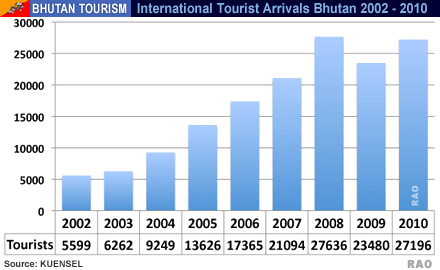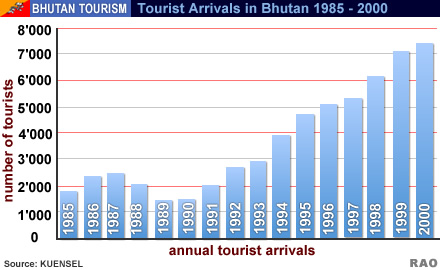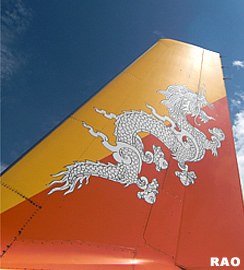|
Tourism
Industry in Bhutan
|
 |
Bhutan's
Economy: Tourism |
|
|
 |
 
|
Tourist Arrivals 2010
|
 |
2010: Bhutan received 40,873 high-end tourists
 |
| Bhutan received 40,873 high-end tourists in 2010 exceeding its own target of 35,000 tourists for the year by nearly 17% .
Of the total high-end arrivals, Bhutan received a record 28,463 international tourists demonstrating the impact of the tourism initiatives including marketing, promotion and enhancement of quality of services. |
|
Tourist arrivals in 2010
Bhutan received 40,873 high-end tourists in 2010 exceeding its own target of 35,000 tourists for the year by nearly 17% . World Tourism Organization defines tourists as people who "travel to and stay in places outside their usual environment for more than twenty-four (24) hours and not more than one consecutive year for leisure, business and other purposes not related to the exercise of an activity remunerated from within the place visited". In fact, keeping with the government policy of considering only high-end tourists arrivals, TCB has been conservative by excluding the regional leisure tourists entering Bhutan by road in the overall tourist arrivals.
Of the total high-end arrivals, Bhutan received a record 28,463 international tourists demonstrating the impact of the tourism initiatives including marketing, promotion and enhancement of quality of services. This figure has been achieved despite events such as ash clouds in the Europe and political situations in the major gateways to Bhutan. While international arrivals for leisure purposes touched 27,196, marking a growth of 16% over 2009, international arrivals for business purposes, including MICE (Meetings, Incentives, Conferences, Exhibitions) and FAM visitors, reached 1,267. The latter number is understated due to the fact that information about a large number of MICE visitors was not available. A conservative estimate of 60% has been assumed as the share of international MICE in the total MICE arrivals.
The remaining high-end arrivals of 12,410 were from the regional market as per data received from the Department of Immigration. Here 6,610 arrivals were for leisure purposes, reflecting an impressive growth of 56% over 2009. In addition, 5,800 regional arrivals were for business purposes. The encouraging growth in the high-end regional arrivals staying in tourist class hotels (3* or above), using Drukair and other tourist facilities, underscores the importance of the regional market, especially India, for the tourism sector. This clearly mirrors the growth of economies and income levels in the region. These regional tourists are also important for flattening seasonality (summer months) in line with the overall strategy of the government to make Bhutan an all weather destination.
The tourist arrivals which exceeded expectations contributed to the generation of an additional 2,600 jobs in 2010, taking the total estimated employment figures in the tourism sector to between 17,800 and 19,600.
These include both direct and indirect employment in the sector. This clearly indicates that the sector has exceeded its target of 17,000 jobs by 2010.
Jobs in tourism sector
The sector has generated a total of 7,481 direct jobs. This basis of calculation is consistent with how other countries calculate tourism employment. In fact, this is a conservative estimate when compared to how emerging economies like Sri Lanka or advanced economies like Australia calculate such an employment figure.
In addition to the direct employment, tourism sector also generates indirect employment that includes all the ancillary services to the sector such as restaurants, taxi drivers and other side businesses that support the tourism industry. Based on the report "Tourism Revenue and Employment Generation" by the Government of Bhutan, the indirect employment is nearly 1.5 times the direct employment. This is a conservative estimate when compared to a conversion ratio of 2.5 used in other countries. Between 10,320 and 12,120 of indirect employment has been generated so far in the sector.
In 2010, based on the same logic as described above, a total of 2,600 jobs were added in 2010.
The Royal Government has prioritized tourism as one of the lead sectors in view of its tremendous potential to generate employment and promote socio-economic development thereby contributing to Gross National Happiness. It is heartening to see the increasing collaboration between the different stakeholders within the Ministry and the private sector to contribute towards the growth of tourism in Bhutan. Such collaborative approach can only lead to achieving the aspirational targets of the sector for 2011 and beyond.
| Source: Ministry of Communications MOC, Department of Tourism, Bhutan, 2011 |
 |
top
|
Tourism in Bhutan
|
 |
|
more information on Bhutan
|

|
top
|
Links
|
 |
 |
 |
External
links |
|








